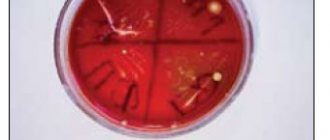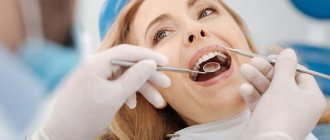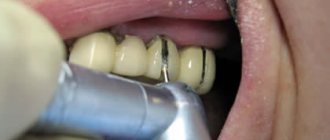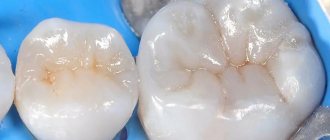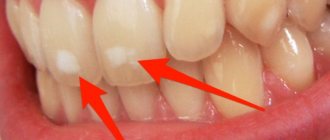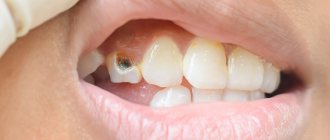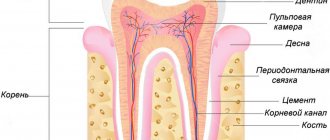When a tooth decays unnoticed, it is considered hidden caries. This name is not used in the specialized literature, but in everyday life of working dentists it is used quite often. To identify this disease, it is necessary to use special diagnostic techniques. For example, it can be difficult to notice caries that has appeared in the gap between the teeth, where food debris gets stuck. Due to the invisibility of caries, which occurs latently, the patient often does not even suspect that he has this disease.
Location of bacteria
Based on the location of hidden caries, it is divided into:
- Contact, located in the space between the teeth. The disease becomes noticeable to a person only after it completely affects the tooth and the onset of severe pain. During the examination, the dentist can determine the onset of hidden caries in the primary stages of the disease. The cause of such caries is the constant presence of food debris between the teeth. Treatment of contact caries is a very unpleasant process.
- Fissure, located in the fissures - cavities of the teeth. It appears as a small darkened spot on the tooth enamel. If you notice it, you should urgently go to the doctor so that the disease does not begin to progress. If the darkened area breaks off, severe pain will begin. This type of caries is treated quite simply.
- Root caries, which affects the root of the tooth, is a very dangerous and difficult to treat disease. It is detected only when not only the root part is affected, but the entire tooth. At the same time, periodontitis usually begins, the root moves away from the gum, becomes exposed and collapses. Often, such caries leads to the loss of the diseased tooth.
- Secondary, developing under the filling. It is detected when pain begins or when a filling is lost due to the growth of the affected cavity. During a preventive examination, it is possible to detect the disease at the initial stage.
The causes of hidden caries are varied. Among them are failure to comply with hygiene rules, sweet foods, lack of vitamins, calcium and fluoride. At the same time, the teeth are poorly cleaned of stones, bacteria multiply in the mouth, and cavities affected by caries develop.
The danger of a latent form of the disease
The fact that latent caries occurs without symptoms is the main problem for its treatment. After all, if it is not identified, treatment will not be started, and the disease will progress, leading to unpleasant consequences.
Most often, this form of caries turns into pulpitis, which manifests itself in damage to the pulp. In this case, the dental nerve is removed. Pulpitis can also turn into periodontitis when the gums of a diseased tooth are affected. In this case, the tooth can often be lost.
The disease can also easily spread to other teeth. Caries, of course, is not contagious, but due to poor cleaning of the interdental space between the affected and healthy teeth from pieces of food, caries occurs on the latter.
Also, the tooth can be destroyed by caries inside the crown, and simply crumble under stress. The problem is that in this case there are no symptoms of caries.
Symptoms and course of the disease
Hidden caries does not appear in the initial stages of the disease and becomes noticeable only after serious damage to the dental tissue. There is no pain, dental lesions are not visible in the mirror. Now, if a filling falls out, this is already an important symptom, meaning that caries is developing. The enamel becomes spotted.
If caries has progressed far, the tooth begins to hurt severely due to temperature changes, from sweet or salty foods. At the same time, the tooth itself does not hurt, only from various causes. When the irritant disappears, the pain immediately goes away. If pain begins to appear on its own, it means that caries has already turned into pulpitis, and the tooth tissue has begun to become inflamed.
If you press on the affected area (chewing food), it also responds with pain. The reason for this is that food penetrates the hole and compresses the vessels and nerves of the pulp. If the remaining food is removed from the affected area, the pain will go away.
Signs and characteristics of the disease
The main danger of hidden caries is that in the first stages it does not manifest itself in any way. There is no pain or external manifestations that the patient could detect. The manifestation occurs when the tooth or its root is already significantly damaged.
If a filling falls out in a tooth, this is the first signal about the presence of a hidden secondary illness. This indicates that the caries cavity under the filling has greatly expanded. In this case, light and dark spots may appear on the enamel.
If the damage is already extensive, the tooth becomes sensitive to cold, hot, salty and sweet foods. At the same time, painful sensations do not appear on their own, they are provoked only by irritants, and when they are excluded, they stop.
Voluntary pain already indicates the transition of the disease to pulpitis when the nerve bundle of the tooth is affected. Mechanical impact (during chewing) on the tooth also causes pain. The pain gradually intensifies and becomes sharp, which not every patient can tolerate. In this case, the pulp will most likely have to be removed and the canals filled.
Features of hidden caries:
- The destruction of the dental organ from the inside occurs; external signs are usually not detected.
- Applies to both chewing and anterior dental organs. In the smile area, it most often occurs in the interdental spaces. On chewing teeth it usually forms in natural depressions (fissures).
- On the front teeth, the disease progresses quickly and affects the pulp, since it is located close to the surface. When removed, the tooth may darken and become brittle, which can contribute to its destruction.
- Affecting the fissures of chewing teeth, the disease usually manifests itself as a small dark spot on the enamel, under which significant destruction is often found.
- If hidden caries could not be diagnosed during a routine examination, but there is still a suspicion of it, X-rays or transluminescence are used. On an x-ray, you can see translucent caries cavities, and with the help of transluminescence, the tooth is illuminated, making the areas affected by caries visible in the form of dark spots.
Diagnosis of hidden caries
Modern diagnostic techniques make it possible to identify a cavity in a tooth affected by caries at any stage of its development. Another thing is that the doctor uses these techniques when there is a suspicion of caries. And these suspicions are precisely difficult to identify - the tooth does not hurt, and the patient is not worried. So often caries remains unnoticed and actively grows. Hidden caries can coexist with ordinary caries, the damage from which is quite noticeable. If there is a lot of tooth decay, an experienced dentist will definitely check for hidden lesions. Diagnostics can be carried out using various methods:
- Laser is very reliable. A special device “Diagnodent” directs a laser beam at the tooth and analyzes the resulting reflection from the tooth being examined.
- X-ray detects lesions in hard-to-reach places, but not in the early stages of development.
- Visual examination with a mirror is the primary method of diagnosis. If the doctor begins to suspect something after the examination, he prefers to use other techniques.
- Transillumination, when the tooth is illuminated with bright light. A photopolymerization lamp can be used for this.
How is the disease determined?
Thanks to new diagnostic methods, it is not difficult to identify hidden caries in dentistry. Where the outbreak formed and how advanced the disease is is unimportant.
But before applying these methods, the dentist needs to identify the presence of a carious process, which is not always possible, because the tooth looks healthy and the patient does not complain about it. Therefore, caries often goes unnoticed and gradually develops.
Often there is a joint course of latent caries with another carious process, which is easy to identify by visual examination. If the patient has a large number of injuries, a good specialist will carefully check all dental organs for the presence of hidden carious formations. To do this, use the following diagnostic methods:
- Laser. This is a very reliable method, which is performed using a device called “Diagnodent”. This device detects a lesion by reflecting a laser beam from the affected area, creating a characteristic sound.
- Radiography. Hidden caries can be seen on an x-ray, but only in cases where it has already developed significantly.
- Visual inspection using a mirror and dental instruments. This method is used initially. So, the probability of a carious lesion is determined, which is then checked, if necessary, by other methods.
- Transillumination involves the use of a photopolymerization lamp, the light from which is directed onto the tooth, and when caries is detected in it, dark spots become noticeable.
Due to the impossibility of diagnosing latent caries on your own, it is important to make regular visits to the dentist for preventive examinations.
Treatment options
A hidden type of caries is treated like any other: damaged tooth tissue is removed and the tooth is filled. If the enamel is damaged or stains appear on it, the tooth must be opened. Products containing calcium and fluoride help restore enamel. When caries forms behind the filling, the cavity is cleaned out and the filling is installed again. This process is done under local anesthesia.
If the disease is advanced, the doctor removes the affected tissue and puts on a crown. Treatment may include tooth extraction and installation of an implant.
Case from practice. There is a whole tooth between the teeth that have caries. Due to suspicion of infection of the tooth, an X-ray examination was performed, which revealed damage to the tooth tissue. The pulp remained intact, but the bone substance was cleaned and the tooth was filled.
Causes
Carious lesions have different etiologies. The most common reasons:
- poor oral hygiene;
- excessive consumption of foods containing sugar;
- gastrointestinal diseases;
- lack of minerals and vitamins, etc.
If the enamel ceases to receive the necessary nutrition, then pathogenic microorganisms enter its layers, destroying hard tissue. This leads to the development of caries.
Prevention of caries
Preventive actions:
- maintaining oral hygiene (brushing teeth 2 times a day, at least 2 minutes);
- the use of suitable devices taking into account the individual characteristics of the oral cavity, fluoride-containing pastes;
- scheduled visits to the dentist at least 2 times a year;
- exclusion of solid foods from the diet;
- reducing sugar consumption;
- timely elimination of infectious foci.
Treatment
Measures to eliminate caries are selected taking into account the depth and neglect of the lesion, as well as the localization of the lesion.
Basic techniques:
- The initial stages of caries are eliminated by opening the lesion. The destroyed tissue is removed with a bur, and the resulting space is filled with a composite filling.
- To strengthen the enamel, remineralization is carried out.
- Damage localized in the fissures is eliminated using gentle methods, with the removal of small areas.
- To treat recurrent caries, the doctor removes the old filling, carries out cleaning and antiseptic treatment, and then installs a new filling.
- The most complex treatment is required in the case of caries localized under soft tissues. To eliminate it, carious cavities are cleaned, and sometimes dental canal treatment is necessary. Seals are installed on the internal and external surfaces after pre-treatment with antiseptics.
- If the tooth cannot be restored, it is removed followed by prosthetics.
Possibility of complications
Complications after caries are varied:
- allergy to a developing infection;
- development of inflammation of the gums and facial tissues;
- an infected tooth affects the condition of the body;
- the appearance of flux is possible;
- A jaw cyst may develop.
Painful sensations do not allow high-quality chewing of food, which harms the stomach and intestines. Damage to a tooth can lead to its removal, and this is a serious stress received by the body. Complications can be very serious diseases - pulpitis and periodontitis. With pulpitis, pain appears when biting; this disease can manifest itself even after treatment of caries if the affected tissue is removed poorly. An even more serious complication is periodontitis, which affects nerve bundles and ligaments. Left untreated, it can become a chronic disease.
Questions
Question
— My hidden caries was not discovered until the tooth began to hurt. Although I visit a professional specialist regularly. As a result, the tooth was severely crumbled, and I had to put a crown on it.
Answer
— The reasons for this situation may be different. Either the dental canals were poorly treated, or hidden caries developed on the adjacent tooth, or the part where the adjacent teeth touch each other was poorly formed, which injures the gums. It is important to find out the cause of the pain in order to avoid periodontitis of the tooth you treated or caries (and possibly pulpitis) of the neighboring tooth.
Question
— My tooth began to hurt, in which caries was treated 4 years ago. The filling was replaced and a new one was installed. Now it hurts again for two weeks. What to do?
Answer
- You should consult your doctor. The tooth may hurt after the procedure, which will gradually go away, but other situations are also possible, which will most likely have to be identified through x-rays.
Prevention measures
To prevent hidden caries from appearing, you must adhere to the following rules:
- Brush your teeth at least twice a day, paying attention to cleaning hard-to-reach surfaces like the space between your teeth. It is advisable to choose the right toothbrush and toothpaste.
- Drink water that contains fluoride. If there is not enough of this element in the water, the tooth enamel will gradually deteriorate. Drinking water must be fluoridated or seafood must be included in the diet. They also use special rinses.
- Do not eat food that has a high or low temperature; it can cause microcracks to appear on the enamel, into which microorganisms that cause caries can penetrate.
- Visit your dentist twice a year for a physical examination. In this case, dental diseases can be detected in time and treated without any special consequences. When plaque appears on your teeth, you need to have your teeth professionally cleaned and prevent bacteria from spreading.
How is caries treated?
The treatment method for caries depends on its stage. At the very beginning of the development of pathology, the enamel is remineralized by saturating it with microelements. A fluoride solution is applied to the tooth to strengthen the tooth surface. For children, medications with a fluoride concentration of no more than 500 ppm are selected. At home, they can use toothpastes designed to prevent caries: Splat Kids, ROCS Kids, Weleda with calendula, Levrana “Orange” or Theodent Kids.
If a carious cavity has formed and caries has penetrated into the dentin, the tooth must be prepared and filled. Treatment can be carried out both under anesthesia and without anesthesia. If the pathology has spread to the pulp, it is removed and then a filling is placed. Filling is carried out according to the following algorithm:
- cleaning the carious cavity from necrotic tissue;
- disinfection of the tooth surface with an antibacterial agent;
- installation and drying of the protective gasket;
- application of composite material;
- grinding and polishing the filling after hardening.
The filling should not prevent a person from chewing food and brushing his teeth. If it is installed incorrectly, secondary caries may develop. After treatment, it is necessary to engage in prevention.
How to recognize the problem
Hidden caries is very similar in the course of the disease to its usual form. The severity of destruction of enamel and dentin tissue depends on the degree of damage to a particular area of the dentition.
Most often, caries is hidden in the following areas:
- spaces between teeth, especially on the inside of the mouth;
- in the area of loose fit of a filling or crown;
- the subgingival part of the tooth, where food debris accumulates in the periodontal sacs and this causes the development of pathogenic microorganisms;
- in fissures.
The root cause of late diagnosis is the inaccessibility of the listed areas for both teeth cleaning and diagnostics. Once an advanced form of caries is detected, treatment is quite complex and lengthy, and sometimes even requires extraction of the unit.
Important! Hidden caries can very quickly move to neighboring teeth and affect their surface.
Symptoms of deep caries
The main symptom is pain, the nature and intensity of which depend on the characteristics of the course of the disease. With the development of an acute form, the entrance hole of the carious cavity is much narrower than its base. The infection quickly penetrates deep and causes significant destruction of distant layers of dentin. Symptoms of acute deep caries:
- A sharp reaction of the tooth to cold or hot, as well as sour, sweet and salty foods.
- Pain when chewing, pressing on the tooth, or getting food debris into the carious cavity.
- When removing the irritant (rinsing), the pain does not go away immediately, since it is difficult to wash out food debris through the narrow opening.
The chronic form of deep caries is characterized by a slow and sometimes asymptomatic course. In this case, pain can only appear when biting on a tooth. The reaction caused by food entering the hollow occurs immediately after rinsing, since in chronic caries the cavity is wide open and its base is narrowed, so irritating factors are easier to remove from it.
Stages of installing veneers
I did a total job for Vitaly - 10 veneers
on the upper and
10 veneers
on the lower jaw. The color chosen was 1M1.
Installation of temporary veneers
When I trimmed him and installed temporary veneers, the first small miracle happened in the life of Vitaly and those around him. Temporary teeth
everyone
at his work ”:
I made the final color of the temporary teeth much lighter than his natural teeth so that the patient could get used to it. He himself asked for this color, I could make it “yellower”. But Vitaly wanted it this way so that he could understand whether he needed such a light color 1M1
. To my slight surprise, he liked everything, and there was such an enthusiastic reaction to his work.
First they did the top, then the bottom. This makes it much more comfortable for both the patient and the doctor. And, of course, for the technician. In my dental practice, there is no such thing that a patient wears only upper veneers and lower teeth. No, I install ceramic veneers on top, and at the same time I grind the lower teeth
, placing temporary veneer structures on them:
They are already lighter and in shape - they are already like future veneers. With this procedure, the patient experiences absolutely no discomfort.
By the way, using Vitaly’s example on the lower teeth, you can see how we grind the teeth
how
minimal
if there is no caries:
Super veneers with dental inlay function
The presented photo shows that caries was removed from the teeth, and the teeth have grooves and depressions
. Typically, such teeth are restored with inlays. And in this case, the solution to this problem was really cool. Namely, I used the missing modules for teeth in the form of veneers, inside of which there is a thickening that fills the entire tooth defect! The thickening inside the veneer completely compensates for the replacement of defects in the tooth crown.
Making a tooth with a veneer with an inlay function
much better than filling a tooth, because fillings shrink and caries can form underneath them. Therefore, due to their shrinkage, fillings are a poor support for veneers. The veneer is best glued not to the filling, but to the tooth.
Many doctors make fillings or put inlays before veneers - in my opinion, this is not a very good option, because it results in two gluings “remains of the tooth crown + inlay + veneer.” It is best to do one gluing - only the tooth and only the missing ceramic module. This ensures reliable adhesion between the veneer and the tooth, ensuring a long service life.
veneers on teeth.
So, in Vitaly’s case, many ceramic veneers had thickenings that acted as inlays, which eliminated all defects in the tooth crown. In general, these are super-veneers
, providing the perfect solution!
